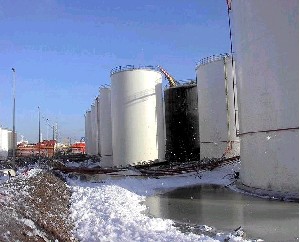In a dockside warehouse of oil and petroleum products, a reservoir containing 1,600 m³ of ortho-cresol broke and a vapour cloud rose in the direction of the nearby Rotterdam metropolitan area. The reservoir collapsed on one of its sides and the roof came loose and slid into the basin. The ortho-cresol, a corrosive, toxic and highly-pungent product, then spread over more than 3 ha of site land area. The accident caused no casualties. Local authorities took control of the terminal during the crisis period. Neighbouring industrial activities were shut down. In addition, sirens were sounded in the adjacent city, public transit service was halted and authorities requested the local population to remain indoors with windows and doors closed. River traffic on the Nieuwe Maas watercourse was also interrupted as was rail traffic on the Rotterdam-Hoek van Holland line. Following the accident, the top priority was site cleanup (consisting of clearing reservoir peripheries and cleaning the retention basin), mitigation of strong odours in the immediate area, and public communications. In all, 17,000 tons of earth were polluted. This accident resulted from failure of the vapour coils, which were composed of a material assembly that lacked sufficient thickness over a 10-cm long segment and that displayed corrosion on the internal surface.
Vapour had penetrated into the reservoir, causing turbulence as well as pressure waves. The vapour pressure reached 7 bar inside the tank, which was full at 96% capacity. With the presence of a weaker zone on the shell caused by a poor-quality weld, the reservoir broke, due not to the vapour expansion-induced pressure surge but rather to the pressure waves.
Download the detailed report in .pdf format (199 Kb)





